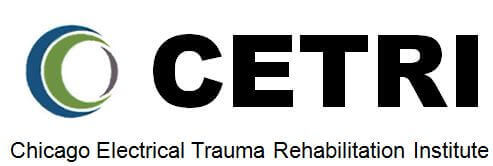ELECTRICAL TRAUMA TERMINOLOGY
Electrical Injury Care Services
ARC-Burn
- When the voltage gradient in the air exceeds 10-20 thousand volts over a distance of about a half-inch, the air breaks down into a hot ionized gas that is a very good electrical conductor. As such, electrical current can pass through the arc to the person and cause electrical injury. Lightning is an example of an electrical arc. The arc is intensely hot and creates a shock wave that may produce significant barotrauma.
ELECTRICAL SHOCK
- This term refers to the noxious experience of having a painful electrical current passed through the body.
ELECTRICAL BURN
- This pertains to heat damage of tissue caused by the flow of electrical current through the tissue.
ELECTROCUTION
- This means death caused by the passage of electrical current through the body,
ELECTROPORATION
- This term relates to the physical disruption of cells or other types of membranes caused by the induction of a large enough voltage across the membrane. For the outer membrane of cells, induction of a trans-membrane potential of more than 0.5 volts for more than one millisecond will form structural defects in the membrane. If large enough, these defects typically do not spontaneously close.
Flash-Electrical Burn
- This refers to the heartburn caused by being in the vicinity of an electrical arc short-circuiting a high-power electrical source. Although intensely hot (i.e., 5,000 - 20,000°C), because of the limited heat capacity of air and the brief exposure, it only produces a superficial skin burn.
HIGH-VOLTAGE SHOCK
- This is common terminology used to indicate that the electrical shock voltage is higher than an arbitrarily selected voltage of 1,000 or 2,000 volts. This alone has very little medical significance because the extent of tissue damage relates more to the voltage difference imposed across the body, the anatomical region involved, the duration of current flow, the frequency of the current, and the electrical power capacity source, and other parameters.
LIGHTNING INJURY
- This term refers to bodily injury caused by lightning contact with the body. Lightning current tends to concentrate on the skin surface, but even a small percentage of the current passing into the body can disrupt neurological or electrical muscle function. Lightning injury can also be mediated by acoustic blast forces (thunder) and strong magnetic pulse induction in the body.
LOW-VOLTAGE SHOCK
- This is common terminology used to indicate that the electrical shock voltage is less than an arbitrarily selected voltage of 1,000 or 2,000 volts. This alone has very little medical significance because the extent of tissue damage relates more to the voltage difference imposed across the body, the anatomical region involved, the duration of current flow, the frequency of the current, and the electrical power capacity source, and other parameters.
